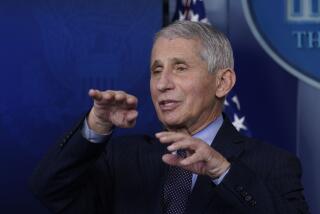David Mahoney; Executive Promoted Brain Research
- Share via
When Norton Simon Inc. CEO David Mahoney lost his bid to buy out the conglomerate in 1983, he suddenly found himself out of a job.
He struggled with retirement for a few years. Then the former advertising man and top executive applied his sharply honed promotional skills to a new venture: selling brain research.
In a few short years, he became what the New York Times called “one of the foremost lay experts in neuroscience,” raising the public profile of, and millions of dollars for, a field that had never had such a vigorous and well-connected advocate.
Called the Mary Lasker of his generation by Nobel laureate James Watson--a reference to Mary Woodard Lasker, the philanthropic dynamo behind the National Cancer Institute and other major biomedical research programs--Mahoney died Monday at his Palm Beach, Fla., home. He was 76.
Mahoney was the chairman and CEO of the New York-based Charles A. Dana Foundation, founded in 1950 to support health and education programs. Under his leadership, the foundation shifted its focus in the health field to neuroscience, committing $34 million to brain research over the past two decades. He helped open up communication among brain researchers around the world and pushed them to take their case to the public through various initiatives, including a 1997 campaign called Brain Awareness Week.
Mahoney established the Dana Alliance for Brain Initiatives, a consortium of 200 of the world’s leading brain researchers, including seven Nobel Prize winners. He spurred the creation of the foundation’s Brain-Body Institute, which raises awareness of the links between the brain and common killers such as heart disease, cancer and strokes.
“This is the best marketing job I’ve ever been involved in,” he told an interviewer several years ago. “We’re on the verge of breakthroughs you can’t believe.”
The Bronx-born Mahoney was a captain in the U.S. Army infantry in Japan during World War II. He attended the University of Pennsylvania on a basketball scholarship, then went to the Wharton School at night on another scholarship. During the day he worked in the mail room of Ruthrauff & Ryan, a New York advertising agency. His rise was so swift that by age 25 he had become one of Madison Avenue’s youngest vice presidents.
Three years later, in 1951, he left to form his own agency, landing as one of his major accounts the Good Humor Co. Good Humor chose Mahoney over Grey, a larger, far better known ad agency, in part because he created a new line of products for the company, including banana splits. Within five years, the 33-year-old Mahoney was president of Good Humor.
That was the beginning of a rapid ascent: At 38, he was executive vice president of Colgate-Palmolive. At 43, he was president of Canada Dry. And at 46, he became president and chief operating officer of Norton Simon, a conglomerate of Canada Dry, Hunt Foods and McCalls. Under Mahoney’s stewardship, Norton Simon eventually included Avis Rent A Car, Halston, Max Factor and the United Can Co.
In 1983, Mahoney was outbid by the Esmark Corp. for the company he had built into a $3.5-billion conglomerate. At 60, he walked away from Norton Simon with as much as $40 million, by some accounts. But he was unwilling to fade into retirement.
After leaving Norton, he began to consider the ways his personal philanthropy could have the greatest impact. He contributed $1.7 million to fund the David Mahoney Institute of Neurological Sciences at his alma mater, the University of Pennsylvania. In 1990, he endowed the Mahoney Neuroscience Institute at Harvard University.
“I thought the next cutting edge of the world was the brain,” he once said.
By 1992, when he was the chief executive of the Dana Foundation, he began to turn its agenda toward the field that had become his consuming interest. That year he founded the Dana Alliance for Brain Initiatives, which developed an award-winning public radio series, “Gray Matters,” in 1997 and a public television series, “Exploring Your Brain,” in 1998.
He conceived the Brain Awareness Week campaign, which brought neuroscientists together with about 400 agencies and organizations to host lectures, exhibits and other events to illustrate advances made in brain research.
“He used his skills in business to develop a very effective interface between brain scientists and the public, and between science and government,” said Mark Konishi, a leading brain researcher at Caltech. “He was a very charismatic person.”
Mahoney, who had homes in Palm Beach and Lausanne, Switzerland, is survived by his wife Hildegarde, a son, two stepsons and seven grandchildren.
More to Read
Inside the business of entertainment
The Wide Shot brings you news, analysis and insights on everything from streaming wars to production — and what it all means for the future.
You may occasionally receive promotional content from the Los Angeles Times.










